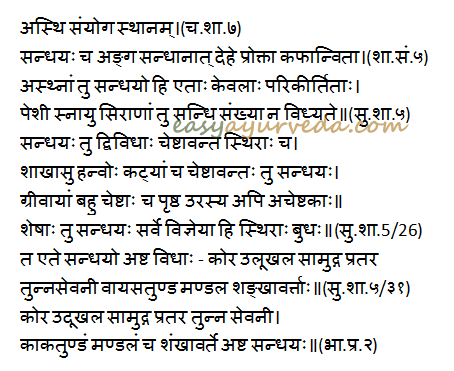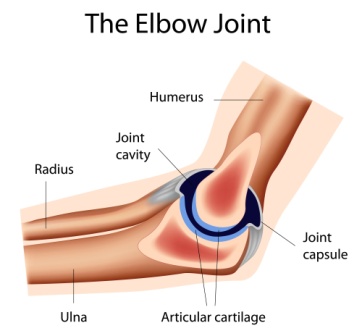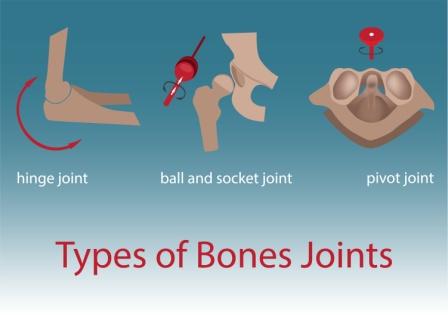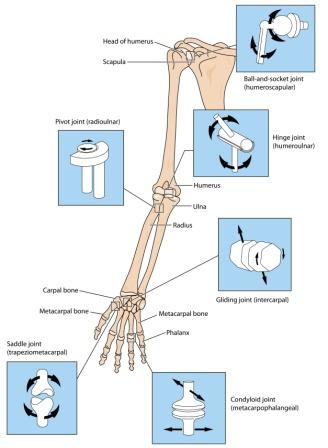Sandhi Shareera: Study of Bone Joints As Per Ayurveda
Article by Dr Manasa, BAMS and Dr Raghuram Y.S. MD (Ay)
Our life is evolved on the ‘art of locomotion’. The human kind has evolved being wanderers and hunters in constant search of a stable piece of Earth and amenities for living. Life would not have been easy if we could not have moved around, thanks for the wonderful anatomy and designing of the human body.
We move on our joints, the junctions of bones well supported by soft tissues like muscles, ligaments and tendons. The flexibility and wide range of movements specialized and programmed in different ways in different bony joints makes our life movements possible.
Table of Contents
Sanskrit verse

Movement is the key for progression and success. And the joints of our body are the keys for movement.
‘If everyone is moving forward together, then success takes care of itself’ – Henry Ford
Sandhi Shaareera
Sandhi=Bony joints of the body
Shaareera=Study of body and its parts
Sandhi Shaareera means the study of joints (bony joints) of the body. Sandhi Shaareera can be simulated with Ayurvedic Arthrology (Arthrology=study of joints).
The term Sandhi means samyoga or junction or union or meeting place or association.
In this context sandhi means ‘asthi samyoga sthaana’ or the place where bones meet. Thus sandhi or joint is formed when 2 or more bony ends meet at a place.
According to other opinions (Sharangadhara Samhita), sandhis are also the meeting place of any two structures in the body. Such sandhis are held together by Kapha.
In general for the purpose of understanding, only asthi-sandhi or bony joints are considered under the term sandhi or sandhis (plural). Other joints like the joints between muscles, blood vessels, ligaments, tendons, etc are usually not considered for counting and description.

‘I figured my body always would be able to repair itself. I think all of us believe that – until you begin to age and get hit with deteriorating joints’ – Lee Majors
Classification of Sandhis
Based on range of movements
The Sandhis are broadly classified into two groups –
Cheshtavanta or Cheshta yukta sandhis (Movable joints or Diarthroses) – These are the joints which permit free movements. These joints are more flexible and move in various directions with liberty. They are found in shakaas (limbs), hanu (jaw) and kati (pelvis).
Cheshtavanta sandhis are again of two types:
Bahu-cheshtayukta sandhis – These joints allow wide range of movements. These types of joints are found in the limbs (elbow, knee, shoulder joints etc) and lower jaw (temporo-mandibular joint).
Alpa cheshtayukta sandhis – These are also movable joints but permit only a small range of movements (in comparison to bahu cheshtayukta sandhis). Such joints are found in the vertebral column.
Sthira sandhis or Acheshta sandhis (Immobile joints) – These are the joints which do not permit movements and are stable. All the other joints apart from those explained in Cheshtavanta sandhis are considered as Sthira Sandhis.
‘My joints hurt. I’m slower. But I remember what it was like to run and play with the boys. I want to be one of the boys.’ – Ted Danson

Based on structure of joint
Classification of Sandhi based on ‘structure of joints’
Based on the structure and shape of the joints, sandhis are of 8 types. They are as described below –
Kora Sandhi – These are in the shape of hinges and are totally mobile in one direction while partially mobile in the opposite direction. Examples of such sandhis are seen in the joints of anguli sandhi (joints of the fingers, inter-phalangeal joints), manibandha sandhi (wrist joint), gulpha sandhi (ankle joints), janu sandhi (knee joint) and kurpara sandhi (elbow joint). These sandhis are compared to Hinge Joints or Gingimus joints.
Ulukhala or Udukhala Sandhi – These are the joints which allow pestle and mortar type of movements. Here the head shaped end of one bone articulates with the socket or pit like surface provided in another bone so as to form a ‘ball and socket’ type of joint. Examples of Ulukhala Sandhi are Kaksha sandhi (shoulder joint), Vankshana Sandhi (Hip Joint), Dashana sandhi (articulation of teeth in their sockets etc. Ulukhala Sandhi can be compared to the Ball and Socket type of joints.
Samudga Sandhi – These types of joints are of box shaped or plate shaped (bowl). Examples of Samudga Sandhi are the joints found in Amsapeetha (glenoid cavity of scapula), Guda (coccygeal) and Nitamba (iliac) regions. These joints can be compared to cavity joints.
Pratara Sandhi – These are just plain type of joints wherein one surface of one bone articulates with the other surface of another bone. Examples of Pratara sandhi can be found in the joints of Greva vamsha (cervical vertebrae) and Prushta vamsha (dorsal or thoracic vertebrae) i.e. articulations in between 2 vertebrae or inter-vertebral joints. These joints are compared to plain joints.
Tunna Sevani Sandhi – These joints are in the form of stitches or sutures between 2 bones, i.e. one feels as if 2 bones have been stitched with each other. Examples of Tunna Sevani Sandhi can be found in the joints of shiraha kapala (sutures of the skull) and kati kapala (suture joints of pelvic bones). These joints can be compared to sutural joints.
Vayasa Tunda Sandhi – This joint is in the shape of the beak of a crow. Example of vayasa tunda sandhi can be found in the joints of Hanu sandhi (Temporo-mandibular joints). These joints can be compared to crow beak joints.
Mandala Sandhi – These are round, fixed and cartilaginous joints found in some structures of the body. Examples of Mandala Sandhi can be found in Kantha (throat), Hrudaya (heart), Netra (eyes), Klomanadi (trachea) etc. These joints can be compared to the cartilaginous joints or annular joints.
Shankavarta Sandhi – These joints are in the form and shape of spiral windings of a conch. Examples of Shankavarta sandhi can be seen in the joints of the srotra (ear) and sringataka regions. These joints can be compared with the spiral and cartilaginous or membranous and fixed joints.
‘Look after you body, because I am 44, and things are happening that I never dreamed of – like bad joints and man boobs!!’ – Louis Theroux

Number of Sandhis
According to Sushruta, the sandhis or bony joints are 210 in number. The distribution is as mentioned below –
Shakagata Sandhi (joints in the limbs) – 17 joints x 4 limbs = 68 joints
Below mentioned are the 17 joints in each limb (1 limb)
- Anguli (in fingers and toes) – 3×4 = 12
- Angushta (thumb, big toe) – 02
- Janu (knee) / Kurpara (elbow) – 01
- Gulpha (ankle) / Manibandha (wrist) – 01
- Vankshana (hip) / Kaksha (shoulder) – 01
Koshtagata Sandhi (joints of the trunk) – 59 Sandhis
- Kati kapala / Shroni (Hip, pelvis) – 03
- Prushtavamsha (spine) – 24
- Parshwa (sides of the trunk) – 24
- Uras (chest) – 08
Urdhwa Jatru Sandhis (Joints located in the head and neck) – 83 sandhis
- Greeva (neck) – 08
- Kantha (throat) – 03
- Hridaya / Kloma nadi (Heart / trachea) – 18
- Dantamula (roots of teeth) – 32
- Kakalaka – 01
- Nasa (nose) – 01
- Vartma mandala (orbit, eye brow) – 02
- Ganda (maxillae) – 02
- Karna (ear), Shankha (temples) – 04
- Hanu sandhi (mandibular joint), Bhru (eye brows), Shanka upari (above temples – 06
- Shiraha kapala (cranial sutures) – 05
- Murdha (head) – 01
Charaka has mentioned 290 Sandhis whereas Vagbhata has mentioned 2000 sandhis.
‘Moving on, is a simple thing, what it leaves behind is hard’ – Dave Mustaine
Just Before Finishing –
Joints are not only of anatomical and structural importance, their knowledge is also needed for medicinal science. Joint disorders are the most common life-style disorders encountered in clinical practice. Their incidence is increasing constantly keeping in pace with the evolution. Sandhis are the abodes of Kapha, mainly shleshaka kapha which helps in keeping them functional and integrated along with providing good lubrication. Sandhis aare also marmas or important delicate points or sensitive structures, the injury of which leads to death (damage, degeneration) or deformity. A thorough structural and functional knowledge of the sandhis is needed to address their pathology.
Sandhi Shaareera or study of joints in Ayurveda is based on the ancient wisdom of the Ayurveda seers and teachers. Their way of seeing and classifying the joints looks different but all appreciations go its way because it was the first attempt made at understanding the most important structures of our body. Arthrology of modern day anatomy is the essence of all these basics which were provided long back in timeline. This article was to give an account of the Ayurvedic perspective of ‘study of bony joints’.
‘Man maintains his balance, poise, and sense of security only as he is moving forward’ – Maxwell Waltz
Click to Consult Dr Raghuram Y.S. MD (Ayu)










6 comments on “Sandhi Shareera: Study of Bone Joints As Per Ayurveda”
Ravi
Please write articles on treatments and joint longevity pointers that are there in the AYURVEDA.What you are doing is great service to all of us interested in the real science which Ayurveda surely is. What you have written is great and worth reading but it is more of like studying for exams rather than what a layman wants.I hope you will get the point. Thank you.
Dr J V Hebbar MD(Ayu)
https://www.easyayurveda.com/2016/12/30/home-remedies-for-morning-stiffness-in-joints/
https://www.easyayurveda.com/2016/01/24/osteoarthritis-sandhivata-ayurvedic-treatment-remedies/
https://www.easyayurveda.com/2016/01/29/early-stage-of-rheumatoid-arthritis-ayurvedic-treatment/
Rachana
Enough information for 1st BAMS students
Dr J V Hebbar MD(Ayu)
All the best 🙂
Peeyush Pandey
Sir ,
Please advise the ayurveda treatment available for AVN.
Dr J V Hebbar MD(Ayu)
Namaste 🙂
I request you to consult Dr MS Krishnamurthy MD(Ayu), PhD, who is 8 years senior to me and is a better Ayurvedic Clinician.
He offers email and video consultations.
Fee etc. details here
https://easyayurveda.com/krishnamurthy